 |
|
|
|
Year 2018 - Volume 38, Number 11
|

|
Effect of calcium sources in the diets of adult cats on urinary parameters and acid-base balance, 38(11):2133-2138
|
ABSTRACT.- Halfen D.P., Kessler A.M., Trevizan L., Vendramini T.H.A., Santos J.P.F., Pedrinelli V., Brunetto M.A. & Carciofi A.C. 2018. Effect of calcium sources in the diets of adult cats on urinary parameters and acid-base balance. [Efeitos das fontes de cálcio na dieta de gatos adultos sobre parâmetros urinários e equilíbrio ácido‑básico.] Pesquisa Veterinária Brasileira 38(11):2133-2138. Departamento de Nutrição e Produção Animal, Faculdade de Medicina Veterinária e Zootecnia, Universidade de São Paulo, Av. Duque de Caxias Norte 225, Pirassununga, SP 19635-900, Brazil. E-mail: mabrunetto@usp.br
Calcium is a macroelement that is part of the mineral composition of the diet of companion animals, and is considered a cation of strong alkalizing power, increasing urinary pH. Calcium salts have different solubilities and depending on the anion to which calcium is associated with, it can be more or less absorbed, modifying the pH of the urine. The aim of this study was to evaluate the efficiency of calcium sources on alkalinization of urinary pH, as well as excretion of urinary electrolytes and acid-base balance of adult cats. An extruded diet for cats was selected, and had 160mEq/kg of calcium from the sources of either calcium carbonate (CaCO3) or calcium gluconate (C12H22CaO14) added. In the control treatment there was no addition of calcium sources, resulting in three treatments. Nine adult cats were used, mixed breed, in two experimental periods, with six replicates per treatment. Animal average age was 4±1.3 years old and average weight was 3.96±0.71kg. The cats remained in metabolic cages for an adaptation period of seven days, followed by six days of urine total collection, with volume, density, pH and calcium concentration (g/d) measurements. The acid-base balance was studied by blood gas analysis of venous blood. The two sources of calcium alkalinized the urine (P<0.001). However, calcium gluconate had less alkalinization power compared to the calcium carbonate (P<0.05). Urinary calcium was not affected by treatments, and represented less than 0.5% of calcium intake. The experiment showed that calcium, although an alkaline cation and considered strong influencer of the EB of the diet, cannot be evaluated individually, because depending on its associated anion it may have greater or lesser influence on cats urine pH.
|
| |
|
|
| |
|
 |